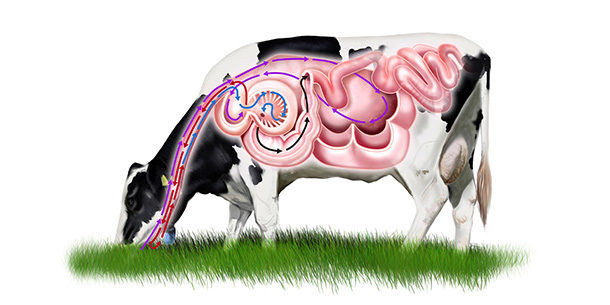The most unique characteristic of a dairy cow is the rumen, the large fermentation vat that utilizes microbes to convert the feed she consumes into the nutrients she needs. She is able to take feedstuffs that other animals, including humans, cannot use and extract nutritive value from them to produce milk.
Even though the rumen has some inefficiencies, it does have some advantages over monogastric animals, including:
- It can utilize forages as an energy source via microbial fermentation of carbohydrates and conversion to volatile fatty acids.
- Rumen microbes can detoxify mycotoxins and lessen their effect on the animal.
- Rumen microbes increase phosphorus availability due to endogenous production of phytase.
- Rumen microbes are major contributors of B vitamins, reducing the need to supplement relative to monogastric animals.
- Microbes can convert lower-cost, non-protein nitrogen (NPN) sources, like urea, to a superior source of metabolizable protein (MP) thereby reducing protein supplementation costs.
This begs the question, are we making the most of this unique functionality, particularly when it comes to maximizing protein efficiency in our dairy cows? In recent years, much of the focus of protein nutrition has been on feeding ingredients that bypass the rumen, but we can’t ignore the benefits that come from feeding the rumen correctly.
The rumen is key to maximizing nitrogen efficiency
Rumen bypass protein sources have gotten most of the attention because nitrogen conversion to milk protein is extremely inefficient in dairy cattle. One 2009 study found that the average nitrogen efficiency is just 24.7%. This is a problem for dairy producers for a couple of reasons.
The first reason is that — since dairy cattle utilize protein inefficiently — you must supplement higher levels of protein to achieve their desired level of milk production. Because protein tends to be the most expensive component of a typical dairy ration, the rising cost of feed is an incentive to improve protein efficiency in dairy cattle.
The other reason is the impact high protein supplementation has on the environment. As you increase the amount of protein you are supplementing, you also increase the amount of nitrogen that is being excreted into the environment through urine. Localized regulations, particularly near watersheds and urban populations, will continue to become more restrictive and have an impact on your nutritional practices. As environmental stewards, reducing dietary protein is the most efficient tool for reducing nitrogen losses on your dairy operation.
To achieve higher levels of milk production, many dairy producers tend to focus on supplementing bypass protein and amino acids, but the best way to improve profitability and environmental sustainability is to focus on feeding the rumen first.
You can begin maximizing dairy production by providing the correct array of amino acids via metabolizable protein, with emphasis on the first two commonly limiting amino acids, lysine and methionine. For example, a 1,500-pound Holstein cow producing 95 pounds of milk (3.8% fat and 3.2% true protein) in her second lactation requires over 3,000 grams (6.6 pounds) of MP per day to sustain this level of production.
To supply this copious amount of MP, one needs to prioritize maximizing microbial protein yield in the rumen. This is accomplished by providing the rumen microbes with energy sources that include sugar, starch, soluble fiber, and digestible NDF and balancing these rumen-available energy sources with rumen-degradable protein (RDP; ammonia, amino acids and peptides). Then you correct the remaining MP deficit with rumen-undegradable protein (RUP). That may include feeds such as rumen protected soybean meal, distiller grains, porcine byproducts and rumen-protected amino acids (lysine and methionine).
Optimize nutrition to improve rumen efficiency
With the right nutrition and the right amino acid balance in the rumen, we can improve microbial protein efficiency. This will help your operation because it can:
- Reduce the need for supplementing more expensive bypass proteins, which may improve your operation’s profitability.
- Reduce the amount of wasted protein excreted into the environment, improving the sustainability of your operation.
This is Part 1 of a series examining protein efficiency and rumen function.
References omitted but are available upon request by sending an email to the editor.






